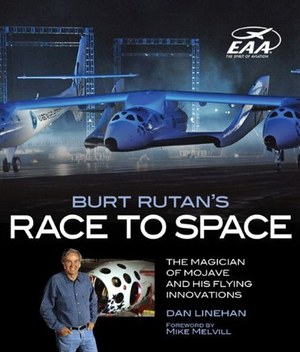Review: Burt Rutan’s Race to Spaceby Jeff Foust
|
| “I always had the space bug, keep in mind,” Rutan says in the book. “When did I jump in and do it myself? It came in a time when I thought I could do it.” |
Linehan, who previously wrote about the development of SpaceShipOne (see “Review: SpaceShipOne: An Illustrated History”, The Space Review, June 16, 2008), expands his focus in Burt Rutan’s Race to Space to Rutan’s overall aviation work. The first part of the book covers Rutan’s early airplane designs, including the VariViggen, VariEze, and Long-EZ, which won Rutan a following in the aviation community, particularly at events like Oshkosh. Those planes, and others, incorporated the design elements that would become Rutan’ hallmarks: canards, winglets, pusher engines, and the use of composite materials. Those innovations, as Linehan explains, weren’t done simply for their own sake, but to solve specific problems: Rutan incorporated canards, for example, to make it impossible for the plane to stall.
As the title suggests, much of the later portions of the book are devoted to Rutan’s work on SpaceShipOne and SpaceShipTwo. Those were not the first space vehicles his company, Scaled Composites, worked on: the company had previously developed the wings and fins for Orbital Science’s Peasus rocket and the aeroshells for the DC-X and Roton. “I always had the space bug, keep in mind,” Rutan says in the book. “When did I jump in and do it myself? It came in a time when I thought I could do it.” Rutan took as his initial inspiration the air-launched Pegasus, and proposed a one-person capsule lofted from a rocket carried aloft by his Proteus airplane. That concept evolved into SpaceShipOne and White Knight, a process recounted in the book, followed by the ongoing development of SpaceShipTwo and WhiteKnightTwo (the latter, the book notes, is known internally at Scaled as “T-Tops” because of its faint resemblance to a triceratops when SpaceShipTwo is attached, and to avoid confusion with the original White Knight).
Burt Rutan’s Race to Space is not a detailed history of all the aircraft developed by Rutan; Linehan in particular skims through many of the vehicles developed in the 1980s and 1990s to get to his space vehicles. Nor is the book a biography of Rutan, as Linehan focuses primarily on Rutan’s professional work. Instead, the book offers an overview of Rutan’s design achievements over the years, a sampling of the unconventional approaches that won him acclaim. Linehan does a good job not getting too technical, providing backgrounds on topics ranging from how airplanes stall to the various kinds of rocket engines to keep the book accessible to broader audiences. The book is lavishly illustrated with photos and illustrations, some provided directly by Scaled and Rutan, who also sat with Linehan for several interviews.
Burt Rutan’s Race to Space comes out just a few months after Rutan formally retired from Scaled, becoming chairman emeritus of the company. Earlier this month, the company announced Rutan’s “final design” there: a concept vehicle called the BIPOD that is, in effect, a flying car with both gasoline and electric engines. With a mind as fertile as Rutan’s, though, one wonders even as he heads into retirement whether this will truly be his last aircraft design.
